Samsung SCX 465x, SCX 4x21 Service Manual
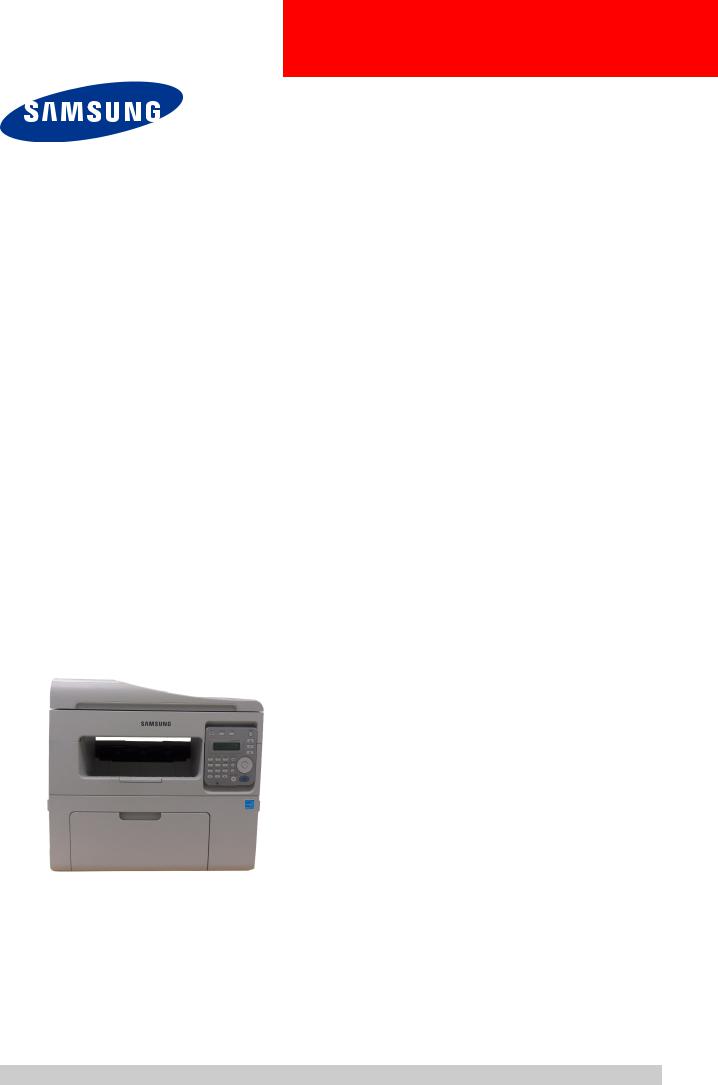
Mono Laser MFP
SCX-465x / 4x21 series SCX-465x / 465xN / 465xF / 465xFN /465xHN / 4021S / 4321NS / 4521FS / 4521NS / 4521HS (Ver_1.0)
SERVICEMANUAL
Mono Laser MFP |
|
Contents |
1. Precautions
2. Product specification and description
3. Disassembly and Reassembly
4. Alignment and Troubleshooting
5. System Diagram
6. Reference Information
Refer to the service manual in the GSPN (see the rear cover) for more information.

Contents
Contents
1. Precautions ...................................................................................................................................... |
|
|
1 |
− |
1 |
|
1.1. |
Safety warning ........................................................................................................................ |
|
1 |
− |
1 |
|
1.2. |
Caution for safety .................................................................................................................... |
|
1 |
− |
2 |
|
|
1.2.1. |
Toxic material............................................................................................................. |
1 |
− |
2 |
|
|
1.2.2. Electric shock and fire safety precautions ......................................................................... |
1 |
− |
2 |
||
|
1.2.3. |
Handling precautions ................................................................................................... |
1 |
− |
3 |
|
|
1.2.4. Assembly and Disassembly precautions........................................................................... |
1 |
− |
3 |
||
|
1.2.5. Disregarding this warning may cause bodily injury ............................................................ |
1 |
− |
4 |
||
1.3. |
ESD precautions...................................................................................................................... |
|
1 |
− |
5 |
|
2. Product specification and description..................................................................................................... |
2 |
− |
1 |
|||
2.1. |
Product Specification................................................................................................................ |
2 |
− |
1 |
||
|
2.1.1. |
Product Overview........................................................................................................ |
2 |
− |
1 |
|
|
2.1.2. |
Specifications ............................................................................................................. |
2 |
− |
2 |
|
|
|
2.1.2.1. |
General Print Engine...................................................................................... |
2 |
− |
2 |
|
|
2.1.2.2. |
Copier......................................................................................................... |
2 |
− |
2 |
|
|
2.1.2.3. |
Scan Specification ......................................................................................... |
2 |
− |
3 |
|
|
2.1.2.4. |
Fax (SCX-465xF_465xFN_465xHN_4521FS_4521NS_4521HS only).................... |
2 |
− |
3 |
|
|
2.1.2.5. |
Controller and Software.................................................................................. |
2 |
− |
5 |
|
|
2.1.2.6. |
Paper Handling............................................................................................. |
2 |
− |
6 |
|
|
2.1.2.7. |
Supplies ...................................................................................................... |
2 |
− |
7 |
|
|
2.1.2.8. |
Maintenance Part .......................................................................................... |
2 |
− |
7 |
|
|
2.1.2.9. |
Reliability and Service ................................................................................... |
2 |
− |
7 |
|
|
2.1.2.10. |
Environment ................................................................................................ |
2 |
− |
8 |
|
2.1.3. |
Model Comparison Table.............................................................................................. |
2 |
− |
9 |
|
2.2. |
System Overview..................................................................................................................... |
|
2 |
− 10 |
||
|
2.2.1. |
Front View................................................................................................................. |
2 |
− 10 |
||
|
2.2.2. |
Rear View |
.................................................................................................................. |
2 |
− 12 |
|
|
2.2.3. |
Paper Path.................................................................................................................. |
2 |
− 14 |
||
|
2.2.4. |
System Layout............................................................................................................ |
2 |
− 15 |
||
|
|
2.2.4.1. |
Feeding Part................................................................................................. |
2 |
− 16 |
|
|
|
2.2.4.2. |
Transfer Roller ............................................................................................. |
2 |
− 17 |
|
|
|
2.2.4.3. |
Drive Unit ................................................................................................... |
2 |
− 17 |
|
|
|
2.2.4.4. |
Fuser Unit.................................................................................................... |
2 |
− 18 |
|
|
|
2.2.4.5. |
LSU (Laser Scanner Unit)............................................................................... |
2 |
− 19 |
|
|
|
2.2.4.6. |
Toner Cartridge............................................................................................. |
2 |
− 20 |
|
|
2.2.5. |
Hardware configuration ................................................................................................ |
2 |
− 21 |
||
|
|
2.2.5.1. |
Main board .................................................................................................. |
2 |
− 24 |
|
|
|
2.2.5.2. |
OPE board ................................................................................................... |
2 |
− 26 |
|
i |
Copyright© 1995-2012 SAMSUNG. All rights reserved. |

Contents
|
|
2.2.5.3. Fax board (4–in-1 model only)......................................................................... |
2 |
− 27 |
||
|
|
2.2.5.4. |
SMPS/HVPS board ....................................................................................... |
2 |
− 28 |
|
|
|
2.2.5.5. |
Electrical Parts Location................................................................................. |
2 |
− 30 |
|
|
2.2.6. |
Engine F/W Contol Algorithm ....................................................................................... |
2 |
− 32 |
||
|
|
2.2.6.1. |
Feeding ....................................................................................................... |
2 |
− 32 |
|
|
|
2.2.6.2. |
Transfer....................................................................................................... |
2 |
− 32 |
|
|
|
2.2.6.3. |
Fusing......................................................................................................... |
2 |
− 33 |
|
|
|
2.2.6.4. |
LSU............................................................................................................ |
2 |
− 33 |
|
|
2.2.7. |
Software Descriptions .................................................................................................. |
2 |
− 34 |
||
|
|
2.2.7.1. |
Software system overview .............................................................................. |
2 |
− 34 |
|
|
|
2.2.7.2. |
Architecture ................................................................................................. |
2 |
− 34 |
|
|
|
2.2.7.3. Data and Control Flow ................................................................................... |
2 |
− 35 |
||
3. |
Disassembly and Reassembly .............................................................................................................. |
3 |
− |
1 |
||
|
3.1. Precautions when replacing parts ................................................................................................ |
3 |
− |
1 |
||
|
3.1.1. |
Precautions when assembling and disassembling ............................................................... |
3 |
− |
1 |
|
|
3.1.2. |
Precautions when handling PBA..................................................................................... |
3 |
− |
1 |
|
|
3.1.3. |
Releasing Plastic Latches.............................................................................................. |
3 |
− |
2 |
|
|
3.2. Screws used in the printer.......................................................................................................... |
3 |
− |
3 |
||
|
3.3. Replacing the Main SVC parts ................................................................................................... |
3 |
− |
4 |
||
|
3.3.1. |
Cover........................................................................................................................ |
|
3 |
− |
4 |
|
3.3.2. |
OPE Unit................................................................................................................... |
|
3 |
− |
5 |
|
3.3.3. |
Scanner Unit............................................................................................................... |
3 |
− |
6 |
|
|
3.3.4. |
ADF unit ................................................................................................................... |
|
3 |
− |
7 |
|
3.3.5. |
CIS (Contact Image Sensor) Unit.................................................................................... |
3 |
− |
8 |
|
|
3.3.6. |
Middle Cover ............................................................................................................. |
3 |
− |
9 |
|
|
3.3.7. |
Main board................................................................................................................. |
3 |
− 10 |
||
|
3.3.8. |
Fax board................................................................................................................... |
|
3 |
− 10 |
|
|
3.3.9. |
SMPS_HVPS board..................................................................................................... |
3 |
− 11 |
||
|
3.3.10. |
Fuser Unit |
.................................................................................................................. |
3 |
− 12 |
|
|
3.3.11. |
Transfer roller............................................................................................................. |
3 |
− 12 |
||
|
3.3.12. |
LSU.......................................................................................................................... |
|
3 |
− 13 |
|
|
3.3.13. |
Feed Sensor PBA ........................................................................................................ |
3 |
− 13 |
||
|
3.3.14. |
Main Drive Unit.......................................................................................................... |
3 |
− 14 |
||
|
3.3.15. |
Pick Up Solenoid......................................................................................................... |
3 |
− 15 |
||
|
3.3.16. |
Pick up roller.............................................................................................................. |
3 |
− 15 |
||
4. |
Alignment and Troubleshooting ........................................................................................................... |
4 |
− |
1 |
||
|
4.1. Alignment and Adjustments....................................................................................................... |
4 |
− |
1 |
||
|
4.1.1. |
Control Panel.............................................................................................................. |
4 |
− |
1 |
|
|
4.1.2. |
Understanding the status LED........................................................................................ |
4 |
− |
5 |
|
|
4.1.3. |
JAM removal.............................................................................................................. |
4 |
− |
6 |
|
Copyright© 1995-2012 SAMSUNG. All rights reserved. |
ii |

Contents
|
|
|
4.1.3.1. Clearing original document jams ...................................................................... |
4 |
− |
6 |
|
|
|
|
4.1.3.2. |
Clearing paper jams ....................................................................................... |
4 |
− |
9 |
|
|
4.1.4. Useful menu item for service ......................................................................................... |
4 |
− 11 |
|||
|
|
4.1.5. |
Periodic Defective Image .............................................................................................. |
4 |
− 12 |
||
|
|
4.1.6. |
Useful management tools .............................................................................................. |
4 |
− 13 |
||
|
|
|
4.1.6.1. Using Samsung Easy Printer Manager (Windows and Macintosh only) .................... |
4 |
− 13 |
||
|
|
|
4.1.6.2. Using Samsung Printer Status (Windows only) ................................................... |
4 |
− 15 |
||
|
|
|
4.1.6.3. Using SyncThru Web Service (SWS) ................................................................ |
4 |
− 16 |
||
|
|
4.1.7. |
Updating Firmware ...................................................................................................... |
4 |
− 18 |
||
|
|
|
4.1.7.1. Update the firmware by using the USB port ........................................................ |
4 |
− 18 |
||
|
|
|
4.1.7.2. Update the firmware by using the network .......................................................... |
4 |
− 19 |
||
|
|
4.1.8. |
Tech mode ................................................................................................................. |
4 |
− 21 |
||
|
4.2. |
Troubleshooting |
...................................................................................................................... |
4 |
− 25 |
||
|
|
4.2.1. Procedure ...............................................................................of checking the symptoms |
4 |
− 25 |
|||
|
|
|
4.2.1.1. ........................................................................................... |
Basic Check List |
4 |
− 26 |
|
|
|
4.2.2. Error Code .....................................................................................and Troubleshooting |
4 |
− 27 |
|||
|
|
4.2.3. |
Image quality ..................................................................................................problem |
4 |
− 35 |
||
|
|
4.2.4. |
Other errors ................................................................................................................ |
4 |
− 41 |
||
5. |
System Diagram................................................................................................................................ |
|
5 |
− |
1 |
||
|
5.1. |
Block Diagram........................................................................................................................ |
|
5 |
− |
1 |
|
|
5.2. |
Connection Diagram................................................................................................................. |
5 |
− |
2 |
||
6. |
Reference Information........................................................................................................................ |
|
6 |
− |
1 |
||
|
6.1. |
Tool for Troubleshooting........................................................................................................... |
6 |
− |
1 |
||
|
6.2. |
Glossary |
................................................................................................................................. |
|
6 |
− |
2 |
|
6.3. The Sample ..................................................................................................Pattern for the Test |
6 |
− |
7 |
|||
iii |
Copyright© 1995-2012 SAMSUNG. All rights reserved. |
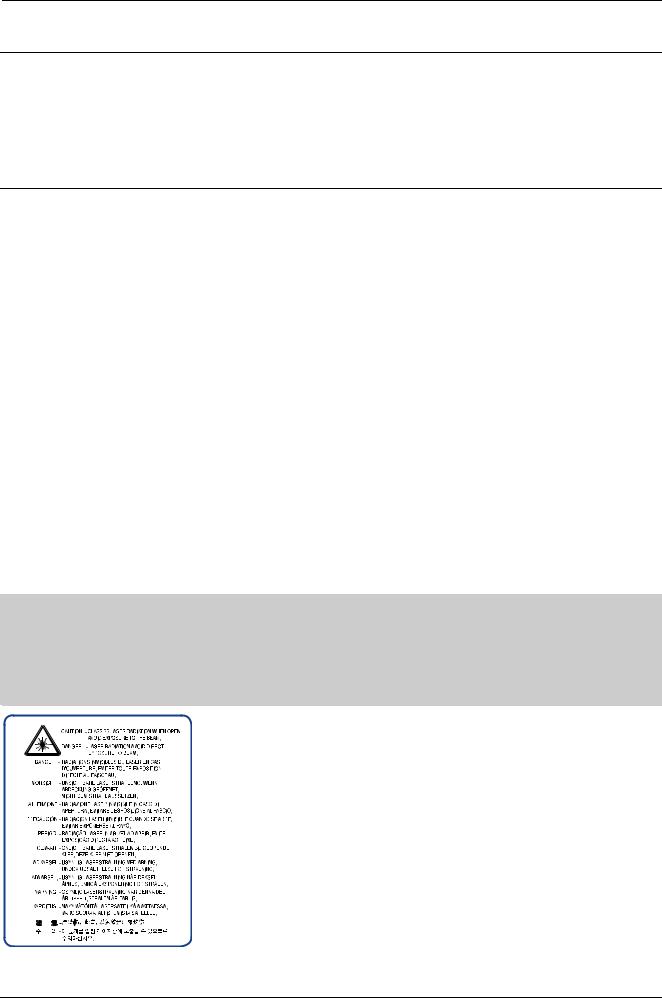
1. Precautions
1. Precautions
In order to prevent accidents and damages to the equipment please read the precautions listed below carefully before servicing the product and follow them closely.
1.1. Safety warning
1)Only to be serviced by a factory trained service technician.
High voltages and lasers inside this product are dangerous. This product should only be serviced by a factory trained service technician.
2)Use only Samsung replacement parts.
There are no user serviceable parts inside the product. Do not make any unauthorized changes or additions to the product as these could cause the product to malfunctions and create an electric shocks or fire hazards.
3)Laser Safety Statement
The printer is certified in the U.S. to conform to the requirements of DHHS 21 CFR, chapter 1 Subchapter J for Class I(1) laser products, and elsewhere is certified as a Class I laser product conforming to the requirements of IEC 60825-1. Class I laser products are not considered to be hazardous. The laser system and printer are designed so there is never any human access to laser radiation above a Class I level during normal operation, user maintenance or prescribed service condition.
•Wavelength: 788 nm (-13/ +12)
•Beam divergence
-Paraller: 8 degrees (-2/ +4)
-Perpendicular: 31 degrees (-6/ +4)
•Maximum power of energy output: 12 mW
 WARNING
WARNING
Never operate or service the product with the protective cover removed from Laser/Scanner assembly. The reflected beam, although invisible, can damage your eyes.
When using this product, these basic safety precautions should always be followed to reduce risk of fire, electric shock, and personal injury.
Copyright© 1995-2012 SAMSUNG. All rights reserved. |
1-1 |

1. Precautions
1.2. Caution for safety
1.2.1. Toxic material
This product contains toxic materials that could cause illness if ingested.
1)Please keep imaging unit and toner cartridge away from children. The toner powder contained in the imaging unit and toner cartridge may be harmful, and if swallowed, you should contact a doctor.
1.2.2. Electric shock and fire safety precautions
Failure to follow the following instructions could cause electric shock or potentially cause a fire.
1)Use only the correct voltage, failure to do so could damage the product and potentially cause a fire or electric shock.
2)Use only the power cable supplied with the product. Use of an incorrectly specified cable could cause the cable to overheat and potentially cause a fire.
3)Do not overload the power socket, this could lead to overheating of the cables inside the wall and could lead to a fire.
4)Do not allow water or other liquids to spill into the product, this can cause electric shock. Do not allow paper clips, pins or other foreign objects to fall into the product, these could cause a short circuit leading to an electric shock or fire hazard.
5)Never touch the plugs on either end of the power cable with wet hands, this can cause electric shock. When servicing the product, remove the power plug from the wall socket.
6)Use caution when inserting or removing the power cord. When removing the power cord, grip it firmly and pull. The power cord must be inserted completely, otherwise a poor contact could cause overheating leading to a fire.
7)Take care of the power cable. Do not allow it to become twisted, bent sharply around corners or power cable may be damaged. Do not place objects on top of the power cable. If the power cable is damaged it could overheat and cause a fire. Exposed cables could cause an electric shock. Replace the damaged power cable immediately, do not reuse or repair the damaged cable. Some chemicals can attack the coating on the power cable, weakening the cover or exposing cables causing fire and shock risks.
8)Ensure that the power sockets and plugs are not cracked or broken in any way. Any such defects should be repaired immediately. Take care not to cut or damage the power cable or plugs when moving the machine.
9)Use caution during thunder or lightning storms. Samsung recommends that this machine be disconnected from the power source when such weather conditions are expected. Do not touch the machine or the power cord if it is still connected to the wall socket in these weather conditions.
10)Avoid damp or dusty areas, install the product in a clean well ventilated location. Do not position the machine near a humidifier or in front of an air conditioner. Moisture and dust built up inside the machine can lead to overheating and cause a fire or cause parts to rust.
11)Do not position the product in direct sunlight. This will cause the temperature inside the product to rise possibly leading to the product failing to work properly and in extreme conditions could lead to a fire.
12)Do not insert any metal objects into the machine through the ventilator fan or other part of the casing, it could make contact with a high voltage conductor inside the machine and cause an electric shock.
13)When replacing the SMPS board, please wait 5 minutes after unplugging the power cord, then replace it. You can get a shock by the electric discharge.
1-2 |
Copyright© 1995-2012 SAMSUNG. All rights reserved. |

1. Precautions
1.2.3. Handling precautions
The following instructions are for your own personal safety to avoid injury and so as not to damage the product.
1)Ensure the product is installed on a level surface, capable of supporting its weight. Failure to do so could cause the product to tip or fall.
2)The product contains many rollers, gears and fans. Take great care to ensure that you do not catch your fingers, hair or clothing in any of these rotating devices.
3)Do not place any small metal objects, containers of water, chemicals or other liquids close to the product which if spilled could get into the machine and cause damage or a shock or fire hazard.
4)Do not install the machine in areas with high dust or moisture levels, beside on open window or close to a humidifier or heater. Damage could be caused to the product in such areas.
5)Do not place candles, burning cigarettes, etc on the product, These could cause a fire.
1.2.4. Assembly and Disassembly precautions
1)Replace parts carefully and always use Samsung parts. Take care to note the exact location of parts and also cable routing before dismantling any part of the machine. Ensure all parts and cables are replaced correctly. Please carry out the following procedures before dismantling the product or replacing any parts.
2)Ensure that power is disconnected before servicing or replacing any electrical parts.
3)Disconnect interface cables and power cables.
4)Only use approved spare parts. Ensure that part number, product name, any voltage, current or temperature rating are correct.
5)When removing or re-fitting any parts do not use excessive force, especially when fitting screws into plastic.
6)Take care not to drop any small parts into the machine.
7)Handling of the OPC Drum
•The OPC Drum can be irreparably damaged if it exposed to light. Take care not to expose the OPC Drum either to direct sunlight or to fluorescent or incandescent room lighting. Exposure for as little as 5 minutes can damage the surface of the photoconductive properties and will result in print quality degradation. Take extra care when servicing the product. Remove the OPC Drum and store it in a black bag or other lightproof container. Take care when working with the Covers (especially the top cover) open as light is admitted to the OPC area and can damage the OPC Drum.
•Take care not to scratch the green surface of OPC Drum Unit. If the green surface of the Drum Cartridge is scratched or touched the print quality will be compromised.
Copyright© 1995-2012 SAMSUNG. All rights reserved. |
1-3 |

1. Precautions
1.2.5. Disregarding this warning may cause bodily injury
1)Be careful with the high temperature part.
The fuser unit works at a high temperature. Use caution when working on the printer. Wait for the fuser unit to cool down before disassembly.
2)Do not put fingers or hair into the rotating parts.
When operating a printer, do not put hand or hair into the rotating parts (Paper feeding entrance, motor, fan, etc.). If do, you can get harm.
3)When you move the printer, use safe lifting and handling techniques.
This printer is heavy. Use the lifting handles located on each side of the machine. Back injury could be caused if you do not lift carefully.
4)Ensure the printer is installed safely.
Ensure the printer is installed on a level surface, capable of supporting its weight. Failure to do so could cause the printer to tip or fall possibly causing personal injury or damaging the printer.
5)Do not install the printer on a sloping or unstable surface. After installation, double check that the printer is stable.
1-4 |
Copyright© 1995-2012 SAMSUNG. All rights reserved. |

1. Precautions
1.3. ESD precautions
Certain semiconductor devices can be easily damaged by static electricity. Such components are commonly called “Electrostatically Sensitive (ES) Devices” or ESDs. Examples of typical ESDs are: integrated circuits, some field effect transistors, and semiconductor “chip” components. The techniques outlined below should be followed to help reduce the incidence of component damage caused by static electricity.
 CAUTION
CAUTION
Be sure no power is applied to the chassis or circuit, and observe all other safety precautions.
1)Immediately before handling a semiconductor component or semiconductor-equipped assembly, drain off any electrostatic charge on your body by touching a known earth ground. Alternatively, employ a commercially available wrist strap device, which should be removed for your personal safety reasons prior to applying power to the unit under test.
2)After removing an electrical assembly equipped with ESDs, place the assembly on a conductive surface, such as aluminum or copper foil, or conductive foam, to prevent electrostatic charge buildup in the vicinity of the assembly.
3)Use only a grounded tip soldering iron to solder or desolder ESDs.
4)Use only an “anti-static” solder removal device. Some solder removal devices not classified as “anti-static” can generate electrical charges sufficient to damage ESDs.
5)Do not use Freon-propelled chemicals. When sprayed, these can generate electrical charges sufficient to damage ESDs.
6)Do not remove a replacement ESD from its protective packaging until immediately before installing it. Most replacement ESDs are packaged with all leads shorted together by conductive foam, aluminum foil, or a comparable conductive material.
7)Immediately before removing the protective shorting material from the leads of a replacement ESD, touch the protective material to the chassis or circuit assembly into which the device will be installed.
8)Maintain continuous electrical contact between the ESD and the assembly into which it will be installed, until completely plugged or soldered into the circuit.
9)Minimize bodily motions when handling unpackaged replacement ESDs. Normal motions, such as the brushing together of clothing fabric and lifting one’s foot from a carpeted floor, can generate static electricity sufficient to damage an ESD.
Copyright© 1995-2012 SAMSUNG. All rights reserved. |
1-5 |

2. Product specification and description
2. Product specification and description
2.1. Product Specification
2.1.1. Product Overview
1)Speed
•Up to 24 ppm in A4 (24 ppm in Letter)
2)Printing Resolution
•Up to 1200 dpi Effective Output (Addressable 1200 x 1200 dpi)
3)Processor
•433 MHz
4)Printer Language Emulation
•SPL (Samsung Printer Language)
5)Memory
•SCX-465x / 465xN / 465xF/ 4021S / 4321NS / 4521FS / 4521HS: 64MB
•SCX-465xFN / 465xHN / 4521NS : 128MB
6)Interface
•High speed USB 2.0
•10/100 BaseTX network connector (SCX-465xN / 465xFN / 465xHN / 4321N / 4521NS only)
7)Toner cartridge
•Initial : 1K
•Sales : 2.5K
Features by models
|
SCX-4650 |
SCX-4650N |
SCX-4655F |
SCX-4655FN |
SCX-4655HN |
SCX-4521HS |
|
SCX-4021S |
SCX-4321NS |
SCX-4521FS |
SCX-4521NS |
||
|
|
|
||||
Fax |
X |
X |
O |
O |
O |
O |
ADF |
X |
O |
O |
O |
O |
O |
Network |
X |
O |
X |
O |
O |
X |
Handset |
X |
X |
X |
X |
O |
O |
|
|
|
|
|
|
|
2-1 |
Copyright© 1995-2012 SAMSUNG. All rights reserved. |

2. Product specification and description
2.1.2. Specifications
•Product Specifications are subject to change without notice.
2.1.2.1. General Print Engine
Item |
|
Specification |
|
Engine Speed |
Simplex |
Up to 24 ppm in A4 (24 ppm in Letter) |
|
|
|
||
Duplex |
Manual Duplex |
||
|
|||
|
|
|
|
Warmup time |
From Sleep |
Less than 30 seconds |
|
|
|
|
|
FPOT |
From Ready |
Less than 10 seconds |
|
|
|
||
From Sleep |
Less than 30 seconds |
||
|
|||
|
|
|
|
Resolution |
|
Up to 1200 dpi Effective Output (Addressable 1200 x 1200 dpi) |
|
|
|
|
2.1.2.2. Copier
Item |
|
Specification |
|
Copy Speed |
Simplex Copy Speed |
SDMC (Text, Text/Photo Mode) : 20 cpm in A4 |
|
|
|
|
|
FCOT (B&W) |
From Ready |
Less than 15 seconds (from platen) |
|
|
|
|
|
|
|
• |
Text: 600 x 300 dpi (Platen) |
|
|
• |
Mixed: 600 x 300 dpi (Platen) |
Copy Resolution |
|
• |
Photo: 600 x 600 dpi (Platen) |
|
• |
Text: 300 x 300 dpi (ADF) |
|
|
|
||
|
|
• |
Mixed: 300 x 300 dpi (ADF) |
|
|
• |
Photo: 600 x 300 dpi (ADF) |
|
|
|
|
Zoom Range |
|
25% to 400% |
|
|
|
|
|
Multi Copy |
|
1~99 |
|
|
|
|
|
Preset |
|
[Original(100%)] |
|
|
|
[Auto Fit] |
|
|
|
[A4 → A5(70%)] |
|
|
|
[LGL→LTR(78%)] ==> Only ADF model |
|
|
|
[LGL→A4(83%)] ==> Only ADF model |
|
|
|
[A4→LTR(94%)] |
|
|
|
[EXE→LTR(104%)] |
|
|
|
[A5 → A4(141%)] |
|
|
|
25%, 50%,150%, 200%, 400% [Custom : 25-400%)] |
|
|
|
|
|
Darkness Control |
|
11 Level |
|
|
|
|
|
Copyright© 1995-2012 SAMSUNG. All rights reserved. |
2-2 |

2. Product specification and description
2.1.2.3. Scan Specification
Item |
|
Specification |
|
||
|
Linearity, Halftone |
15 sec on Platen, |
15 sec on ADF @300dpi |
||
|
|
|
|
||
Scan Speed |
Gray |
23 sec on Platen, |
26 sec on ADF @300dpi |
||
|
|
|
|
||
Color |
256 Color 300 dpi : 65 sec on Platen, 70 sec on ADF |
||||
|
|||||
|
True Color 300dpi : 70 sec on Platen, 70 sec on ADF |
||||
|
|
||||
|
|
|
|
||
Resolution |
Optical |
1200 x 1200 dpi |
|
||
|
|
|
|
||
Enhanced |
4800 x 4800 dpi |
|
|||
|
|
||||
|
|
|
|
||
Halftone |
|
256 levels |
|
||
|
|
|
|||
Scan Size |
Max. Document Width |
Max. 216 mm (8.5") |
|||
|
|
|
|
||
Effective Scan Width |
Max. 208 mm (8.2") |
||||
|
|||||
|
|
|
|
||
|
Color |
• |
Internal: 16 bit x 3 |
||
|
• External : 8 bit x 3 |
||||
Scan Depth |
|
||||
|
|
|
|
||
Mono |
• 1 bit for Lineart & Halftone |
||||
|
|||||
|
• 8 bits for Gray scale |
||||
|
|
||||
|
|
|
|
||
|
|
• |
Windows7(32/64bit)/ 2000/ XP(32/64bit)/ |
||
|
|
|
2003(32/64bit)/ Vista(32/64bit)/ 2008 Server(32/64bit)/ |
||
|
|
|
2008 Server R2(64bit) |
||
|
|
• |
Various Linux OS |
||
|
|
|
• RedHat Enterprise Linux WS 4, 5 (32/64 bit) |
||
|
|
|
• Fedora 5, 6, 7, 8, 9, 10, 11, 12, 13 (32/64 bit) |
||
|
|
|
• SuSE Linux 10.1 (32 bit) |
||
Compatibility |
PC Scan |
|
• OpenSuSE 10.2, 10.3, 11.0, 11.1, 11.2 (32/64 bit) |
||
|
|
|
• Mandriva 2007, 2008, 2009, 2009.1, 2010 (32/64 |
||
|
|
|
bit) |
|
|
|
|
|
• Ubuntu 6.06, 6.10, 7.04, 7.10, 8.04, 8.10, 9.04, |
||
|
|
|
9.10, 10.04 (32/64 bit) |
||
|
|
|
• SuSE Linux Enterprise Desktop 10, 11 (32/64 bit) |
||
|
|
|
• Debian 4.0, 5.0 (32/64 bit) |
||
|
|
• Mac OS X 10.4~10.7 |
|||
|
|
|
|
|
|
2.1.2.4. Fax (SCX-465xF_465xFN_465xHN_4521FS_4521NS_4521HS only)
Item |
Specification |
Compatibility |
ITU-T G3, ECM |
|
|
Communication System |
PSTN/PABX |
|
|
Modem Speed |
33.6 Kbps |
|
|
TX Speed |
Approx. 3 sec (Mono/Standard/ECM-MMR, @ ITU-T G3 No.1 ) |
|
|
Compression |
MH/MR/MMR/JBIG/JPEG |
|
|
Color Fax |
Yes (Tx only) |
|
|
ECM |
Yes |
|
|
2-3 |
Copyright© 1995-2012 SAMSUNG. All rights reserved. |

2. Product specification and description
Item |
|
Specification |
|
Resolution |
Std |
203 x 98 dpi |
|
|
|
||
Fine |
203 x 196 dpi |
||
(Mono) |
|||
|
|
||
S.Fine |
300 x 300 dpi |
||
|
|||
|
|
|
|
|
Handset |
Yes (China, Iran Only) |
|
|
|
|
|
|
On hook Dial |
Yes |
|
|
|
|
|
|
Search |
Yes (Phone Book) |
|
|
|
|
|
|
Speed Dial |
200 locations |
|
|
|
|
|
|
Group Dial |
100 groups |
|
|
|
|
|
Telephone |
TAD I/F |
Yes |
|
Features |
Tone/Pulse |
Selectable in Tech Mode or User Menu (depends on each country) |
|
|
|
|
|
|
Pause |
Yes |
|
|
|
|
|
|
Auto Redial |
Yes |
|
|
|
|
|
|
Last Number Redial |
Yes |
|
|
|
|
|
|
Caller ID |
Yes |
|
|
|
|
|
|
External Phone Interface |
Yes |
|
|
|
|
Copyright© 1995-2012 SAMSUNG. All rights reserved. |
2-4 |

2. Product specification and description
2.1.2.5. Controller and Software
Item |
|
Specification |
|
Processor |
|
433 MHz |
|
|
|
|
|
Supporting OS |
|
• Windows7(32/64bit)/ 2000/ XP(32/64bit)/ 2003(32/64bit)/ |
|
|
|
Vista(32/64bit)/ 2008 Server(32/64bit)/ 2008 Server R2(64bit) |
|
|
|
• Various Linux OS : |
|
|
|
• RedHat Enterprise Linux WS 4, 5 (32/64 bit) |
|
|
|
• Fedora 5, 6, 7, 8, 9, 10, 11, 12, 13 (32/64 bit) |
|
|
|
• SuSE Linux 10.1 (32 bit) |
|
|
|
• OpenSuSE 10.2, 10.3, 11.0, 11.1, 11.2 (32/64 bit) |
|
|
|
• Mandriva 2007, 2008, 2009, 2009.1, 2010 (32/64 bit) |
|
|
|
• |
Ubuntu 6.06, 6.10, 7.04, 7.10, 8.04, 8.10, 9.04, 9.10, 10.04 |
|
|
|
(32/64 bit) |
|
|
• SuSE Linux Enterprise Desktop 10, 11 (32/64 bit) |
|
|
|
• |
Debian 4.0, 5.0 (32/64 bit) |
|
|
• Mac OS X 10.4~10.7 |
|
|
|
|
|
|
Printer |
SPL (Samsung Printer Language) |
|
|
|
|
|
Driver |
TWAIN |
Yes |
|
|
|
|
|
|
WIA |
Yes |
|
|
|
|
|
|
|
• [TCP/IP] |
|
|
Protocol |
TCP/IPv4/IPv6, SMTP, DNS/WINS, DDNS, DHCP, BOOTP, |
|
|
AutoIP, Standard TCP/IP printing, LPR, UPnP(SSDP), Bonjour, |
||
|
|
||
|
|
Telnet, WSD, SLP, SetIP |
|
|
|
|
|
|
|
[Windows] |
|
|
|
• Windows7(32/64bit)/ 2000/ XP(32/64bit)/ 2003(32/64bit)/ |
|
|
|
Vista(32/64bit)/ 2008 Server(32/64bit)/ 2008 Server R2(64bit) |
|
|
|
[Mac] |
|
|
|
• Mac OS X 10.4~10.7 |
|
Wired Network |
|
[Linux] |
|
|
|
• RedHat Enterprise Linux WS 4, 5 (32/64 bit) |
|
|
Supporting OS |
• Fedora 5, 6, 7, 8, 9, 10, 11, 12, 13 (32/64 bit) |
|
|
|
• SuSE Linux 10.1 (32 bit) |
|
|
|
• OpenSuSE 10.2, 10.3, 11.0, 11.1, 11.2 (32/64 bit) |
|
|
|
• Mandriva 2007, 2008, 2009, 2009.1, 2010 (32/64 bit) |
|
|
|
• Ubuntu 6.06, 6.10, 7.04, 7.10, 8.04, 8.10, 9.04, 9.10, 10.04 (32/64 |
|
|
|
bit) |
|
|
|
• SuSE Linux Enterprise Desktop 10, 11 (32/64 bit) |
|
|
|
• Debian 4.0, 5.0 (32/64 bit) |
|
|
|
|
|
Wireless Network |
|
N/A |
|
|
|
|
|
2-5 |
Copyright© 1995-2012 SAMSUNG. All rights reserved. |

2. Product specification and description
Item |
|
Specification |
|
SmarThru |
No |
|
|
|
|
Smart Panel |
No |
|
|
|
|
Printer Settings Utility |
No |
|
|
|
|
Network Scan |
No |
|
|
|
|
Easy Printer Manager |
Yes (Windows, Mac) |
|
|
|
Application S/W |
Scan Assistant |
Yes (Mac) |
|
PC-FAX |
Yes (Send only, Local/Network) |
|
|
NOTE |
|
|
|
4–in-1 model only |
|
|
|
|
|
|
|
|
|
|
Direct Printing Utility |
No |
|
|
|
|
|
Network Application |
SWAS |
SyncThru Web Admin Service 5.0 (Windows) |
|
|
|
|
|
SetIP |
Yes (Windows,Mac,Linux) |
|
|
|
|
2.1.2.6. Paper Handling
Item |
|
Specification |
||
|
|
|
||
Standard Capacity |
|
250-sheet Bin-type Tray @ 75g/m² |
||
|
|
|
||
Printing |
Max. Size |
216 x 356 mm (8.5" x 14.02") |
||
|
|
|
||
Min. Size |
76 x 183 mm (3.0" x 7.2") |
|||
|
||||
|
|
|
||
|
Main Tray |
A4, A5, Letter, Legal, Executive, Folio, Oficio, ISO B5, JIS B5 |
||
|
|
• Minimum Size (Custom) : 76 x 127 mm (3 x 5 inch) |
||
|
|
• |
Maximum Size (Custom): 215.9 x 356 mm (8.5 x 14 inch) |
|
|
|
|
||
Media Size |
Manual Tray |
A4, A5, Letter, Legal, Executive, Folio, Oficio, ISO B5, JIS B5, A6, |
||
|
Envelope Monarch/Com-10/DL/C5/C6 |
|||
|
|
|||
|
|
• Minimum Size (Custom) : 76 x 127 mm (3 x 5 inch) |
||
|
|
• |
Maximum Size (Custom): 215.9 x 356 mm (8.5 x 14 inch) |
|
|
|
|
|
|
|
Duplex |
N/A |
|
|
|
|
|
||
|
Main Tray |
Plain, Thin, Cotton, Color, Preprinted, Recycled, |
||
|
|
|
||
Media Type |
Manual Tray |
Plain, Envelope, Labels, CardStock, Thick, Thin, Cotton, Color, Preprinted, |
||
|
Recycled, Bond, Archive |
|||
|
|
|||
|
|
|
|
|
|
Duplex |
N/A |
|
|
|
|
|
||
|
Main Tray |
60 ~ 90 g/m² (16~ 24lb) |
||
|
|
|
||
Media Weight |
Manual Tray |
60 ~ 163 g/m² (16~ 43lb) |
||
|
|
|
|
|
|
Duplex |
N/A |
|
|
|
|
|
||
ADF Capacity |
|
40 sheets |
||
|
|
|
|
|
ADF Document Size |
|
• |
Width: 142 ~ 216 mm (5.6" ~ 8.5") |
|
|
|
• |
Length: 148 ~ 356 mm (5.8" ~ 14") |
|
Copyright© 1995-2012 SAMSUNG. All rights reserved. |
2-6 |
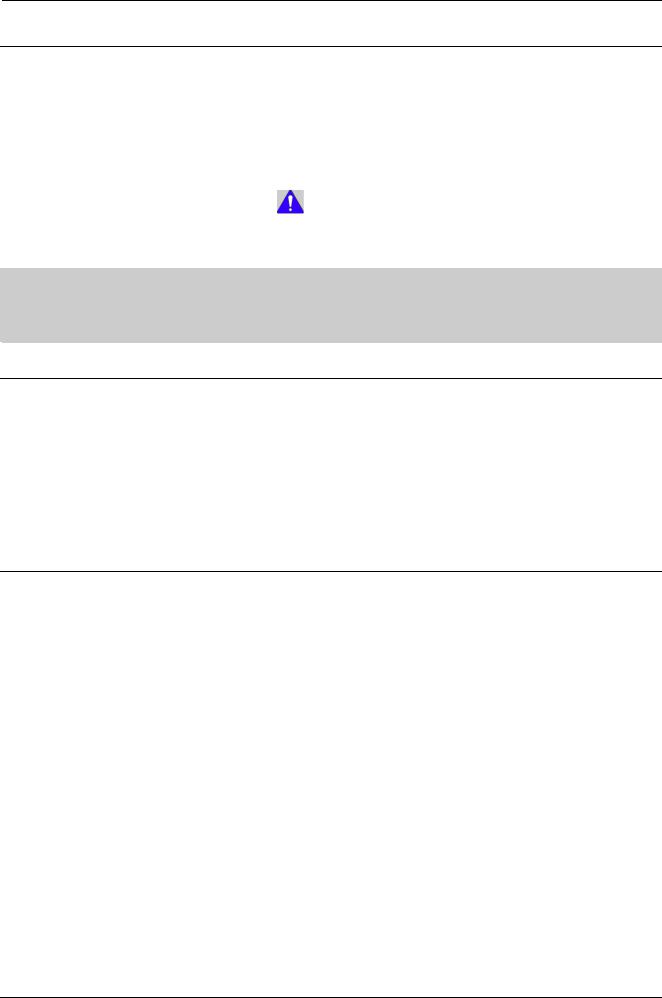
2. Product specification and description
2.1.2.7. Supplies
Item |
|
|
Specification |
|
Toner Cartridge |
Part name |
|
• MLT-D117S |
|
|
|
|
• SCX-D4725A (China, India, Nepal, Bangladesh only) |
|
|
|
|
|
|
|
Average yield |
|
• Average Cartridge Yield 2,500 standard pages |
|
|
|
|
(Ships with 1,000 pages Starter Toner Cartridge) |
|
|
|
|
|
|
|
|
|
NOTE |
|
|
|
|
Declared yield value in accordance with ISO/IEC 19752. |
|
|
|
|
|
|
|
|
|
|
|
 NOTE
NOTE
Declared yield value in accordance with ISO/IEC 19752. The number of pages may be affected by operating environment, printing interval, graphics, media type and media size.
2.1.2.8. Maintenance Part
Item |
Part Code |
Life |
|
Fuser Unit |
• |
JC91-01139B (220V) |
50,000 Pages |
|
• |
JC91–01139A (110V) |
|
|
|
|
|
Transfer Roller |
JC66-01218A |
50,000 Pages |
|
|
|
|
|
Pick-Up Rubber |
JC73-00239A |
50,000 Pages |
|
|
|
|
|
2.1.2.9. Reliability and Service
Items |
Specification |
Monthly Duty Cycle |
10,000 pages |
|
|
Average Monthly Print Volume |
121 pages |
|
|
2-7 |
Copyright© 1995-2012 SAMSUNG. All rights reserved. |

2. Product specification and description
2.1.2.10. Environment
Item |
|
Specification |
||
Dimension (W x D x H)* |
Machine |
• Platen model : 410 x 295 x 341mm |
||
• ADF model : 410 x 295 x 388 mm |
||||
|
|
|||
|
|
|
||
Weight* |
Machine with consumables |
• Platen model : 8.87 Kg |
||
• ADF model : 9.77 Kg |
||||
|
|
|||
|
|
|
||
|
Ready mode |
Less than 26 dB (A) |
||
|
|
|
||
|
Print mode |
Less than 53 dB (A) |
||
|
|
|
||
Noise Level ** |
Copy mode |
• Scanner glass : Less than 53 dB (A) |
||
• Document feeder : Less than 55 dB (A) |
||||
|
|
|||
|
|
|
||
|
Scan mode |
• Scanner glass : Less than 52 dB (A) |
||
|
• Document feeder : Less than 54 dB (A) |
|||
|
|
|||
|
|
|
||
Temperature |
Operation |
10 ~ 32 °C (50 ~ 90 °F) |
||
|
|
|
||
Humidity |
Operation |
20 ~ 80% RH |
||
|
|
|
||
Power rating *** |
110 volt models |
AC 110 - 127 V |
||
|
|
|
||
220 volt models |
AC 220 - 240 V |
|||
|
||||
|
|
|
||
|
Average operating mode |
Less than 450 W |
||
|
|
|
||
|
Ready mode |
Less than 65 W |
||
|
|
|
|
|
|
|
• |
SCX-465x/4021S Series: Less than 1.5 W |
|
Power Consumption |
|
• |
SCX-465xN/4321NS Series: Less than 1.5 W |
|
Power save mode |
• |
SCX-465xF4521FS/4521HS Series: Less than 2.0 W |
||
|
||||
|
|
• SCX-465xFN/465xHN/4521NS Series: Less than 2.5 |
||
|
|
|
W |
|
|
Power off mode |
Less than 0.45 W |
||
|
|
|
|
|
•* Dimensions and weight are measured without a handset.
•** Sound Pressure Level, ISO 7779. Configuration tested: basic machine installation, A4 paper, simplex printing.
•*** See the rating label on the machine for the correct voltage (V), frequency (hertz) and type of current (A) for your machine.
Copyright© 1995-2012 SAMSUNG. All rights reserved. |
2-8 |

2. Product specification and description
2.1.3. Model Comparison Table
|
|
Samsung |
Samsung |
HP |
|
|
|
SCX-4655FN |
SCX-3405F |
M1212nf |
|
Image |
|
|
|
||
|
|
|
|
|
|
Speed (A4) |
24 ppm |
20 ppm |
18 ppm |
||
|
|
|
|
|
|
FPOT |
less than 10 sec |
less than 8.5 sec |
less than 8.5 sec |
||
(from ready) |
|||||
|
|
|
|||
|
|
|
|
|
|
Processor |
433 MHz |
433 MHz |
400 MHz |
||
|
|
|
|
|
|
Memory |
128 MB |
64 MB |
64 MB |
||
|
|
|
|
|
|
Emulation |
GDI |
GDI |
GDI |
||
|
|
|
|
|
|
Paper |
Input |
250 Bin |
150 Bin |
150 Bin |
|
|
|
|
|
||
Output |
100 sheet |
100 sheet |
100 sheet |
||
Capacity |
|||||
|
|
|
|
||
ADF |
40 sheet |
40 sheet |
35 sheet |
||
|
|||||
|
|
|
|
|
|
Noise (Print Mode) |
53 dBA |
50 dBA |
51 dBA |
||
|
|
|
|
||
Toner Cartridge |
2.5K (1K) |
1.5K (0.7K) |
1.6K (0.7K) |
||
|
|
|
|
|
|
2-9 |
Copyright© 1995-2012 SAMSUNG. All rights reserved. |
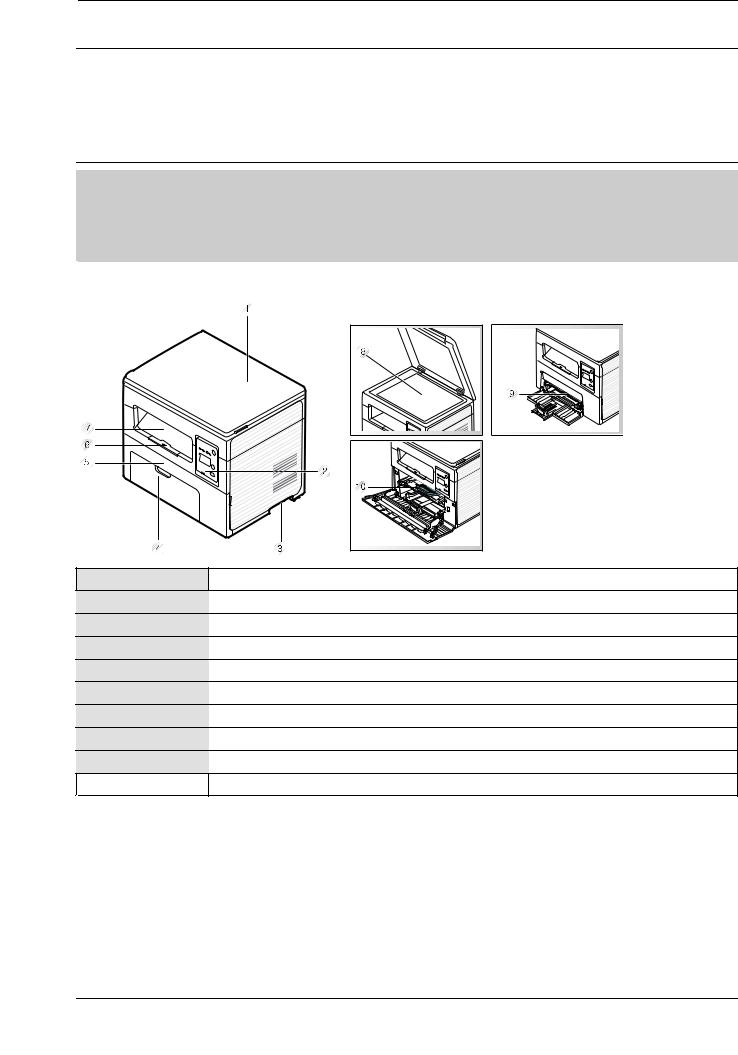
2. Product specification and description
2.2. System Overview
This chapter describes the functions and operating principal of the main component.
2.2.1. Front View
 NOTE
NOTE
•This illustration may differ from your machine depending on your model. There are various types of machine.
•Some features and optional goods may not be available depending on model or country.
Type A (SCX-4650/4021S)
1Scanner lid
2Control Panel
3Handle
4Tray
5Front cover
6Output support
7Output tray
8Scanner glass
9Paper width guide on a manual feeder
10 |
Toner cartridge |
|
|
Copyright© 1995-2012 SAMSUNG. All rights reserved. |
2-10 |

2. Product specification and description
Type B (SCX-465xN/4321NS/465xF/4521FS/4521HS/ 465xFN/465xHN/4521NS)
1 |
Document feeder cover |
2 |
Document feeder guide cover |
3 |
Document feeder output tray |
4 |
Document feeder output support |
5 |
Control panel |
6 |
Handle |
7 |
Tray |
8 |
Front cover |
9 |
Output support |
10 |
Output tray |
|
|
 NOTE
NOTE
* Handset model only
|
|
|
|
|
|
|
|
|
11 |
Scanner lid |
|
|
12 |
Scanner glass |
|
|
13 |
Paper width guide on a document feeder |
|
|
14 |
Document feeder input support |
|
|
15 |
Document feeder input tray |
|
|
16 |
Handset* |
|
|
17 |
Paper width guide on a manual feeder |
|
|
18 |
Toner cartridge |
|
|
|
|
|
2-11 |
Copyright© 1995-2012 SAMSUNG. All rights reserved. |

2. Product specification and description
2.2.2. Rear View
 NOTE
NOTE
•This illustration may differ from your machine depending on your model. There are various types of machine.
•Some features and optional goods may not be available depending on model or country.
Type A (SCX-465x/4021S)
1USB port
2Power receptacle
Type B (SCX-465xN/4321NS/465xF/4521FS/4521HS/ 465xFN/465xHN/4521NS)
1 |
USB port |
2 |
Network port* |
3 |
Extension telephone socket (EXT)** |
4 |
Telephone line socket (Line)** |
5 |
Power receptacle |
|
|
Copyright© 1995-2012 SAMSUNG. All rights reserved. |
2-12 |

2. Product specification and description
 NOTE
NOTE
*SCX-465xN/4321NS/465xFN/465xHN/4521NS Series
**SCX-465xF/4521FS/4521HS/465xFN/465xHN/4521NS Series
2-13 |
Copyright© 1995-2012 SAMSUNG. All rights reserved. |
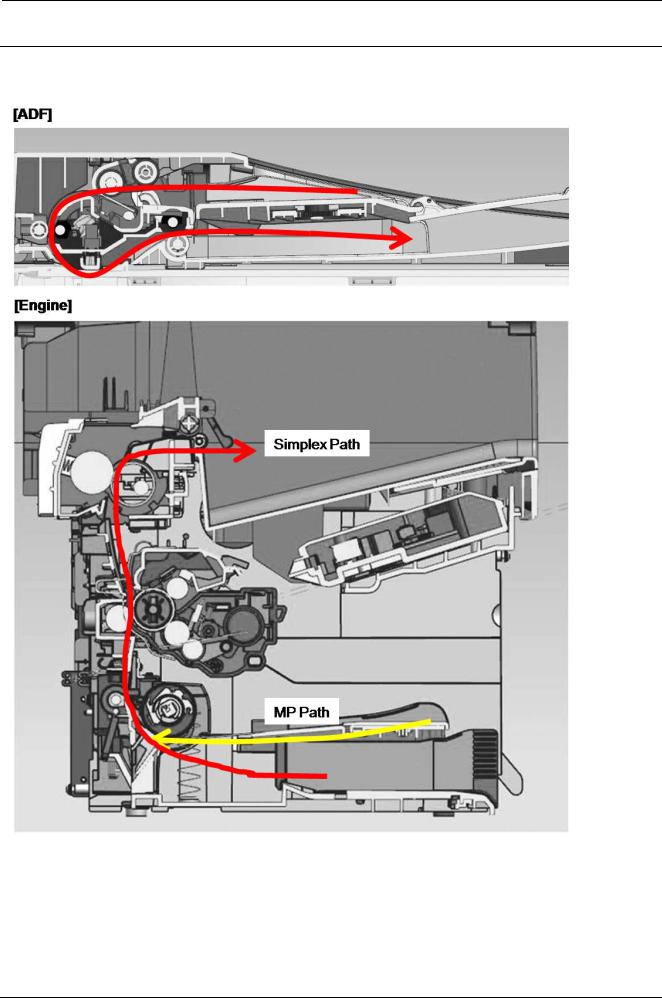
2. Product specification and description
2.2.3. Paper Path
The following diagram displays the path the paper follows during the printing process.
Copyright© 1995-2012 SAMSUNG. All rights reserved. |
2-14 |
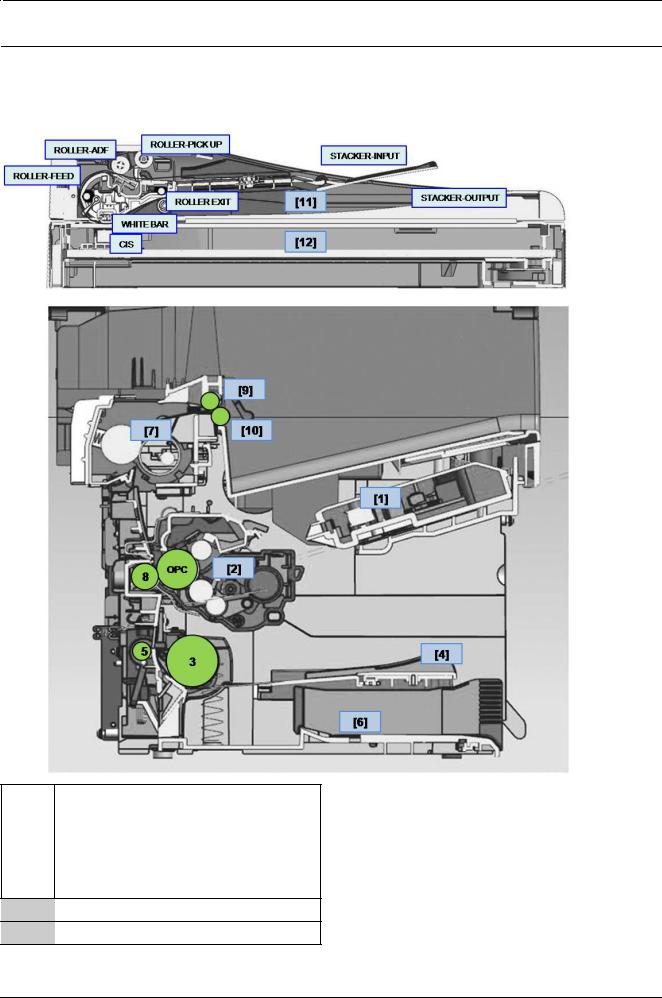
2. Product specification and description
2.2.4. System Layout
This model consists of the scanner parts, engine parts, hardware parts, firmware. The scanner parts consists of ADF and platen. The engine parts consists of the mechanical parts comprising Frame, Toner Cartridge, Drive Unit, Transfer roller, Pick up unit, Fuser, Bin-tray. The hardware parts consists of the main board, SMPS/HVPS board, OPE board, PC interface.
1 |
LSU |
|
8 |
Transfer Roller |
2 |
Toner Cartridge |
|
9 |
Exit Roller |
3 |
Pick Up Roller |
|
10 |
Exit Decurl Roller |
4 |
MP Tray |
|
11 |
ADF Unit |
5 |
Feed Roller |
|
12 |
Platen Unit |
|
|
|
|
|
6Tray
7Fuser Unit
2-15 |
Copyright© 1995-2012 SAMSUNG. All rights reserved. |

2. Product specification and description
2.2.4.1. Feeding Part
It is consists of a bin-type tray, pick-up roller, friction pad and parts related to paper feed initialization.
1) Input Tray
This model has a bin-type tray.
It takes a center loading method and applies ‘friction pad separating method.’
The side guide can be adjusted for various types of papers from A6 to legal size paper. It has a paper detecting function, paper arranging function.
2) Pick-up roller
It has functions such as a paper pickup function, driving control function, paper feeding function, and removing electronic static function. Pick up roller is driven by solenoid.
Copyright© 1995-2012 SAMSUNG. All rights reserved. |
2-16 |

2. Product specification and description
2.2.4.2. Transfer Roller
The transfer roller delivers the toner of the OPC drum to the paper.
•Life Span : Print over 50,000 sheets (in 15~30°C)
2.2.4.3. Drive Unit
The drive unit consists of a step motor, various gears for OPC, Pickup, Feed, Fuser.
•Driving Frequency: Step Motor 880 PPS (1100rpm)
•It is a power delivery unit by gearing: Step Motor → Pick-up/Feeder/Transfer/Fuser/Exit
2-17 |
Copyright© 1995-2012 SAMSUNG. All rights reserved. |
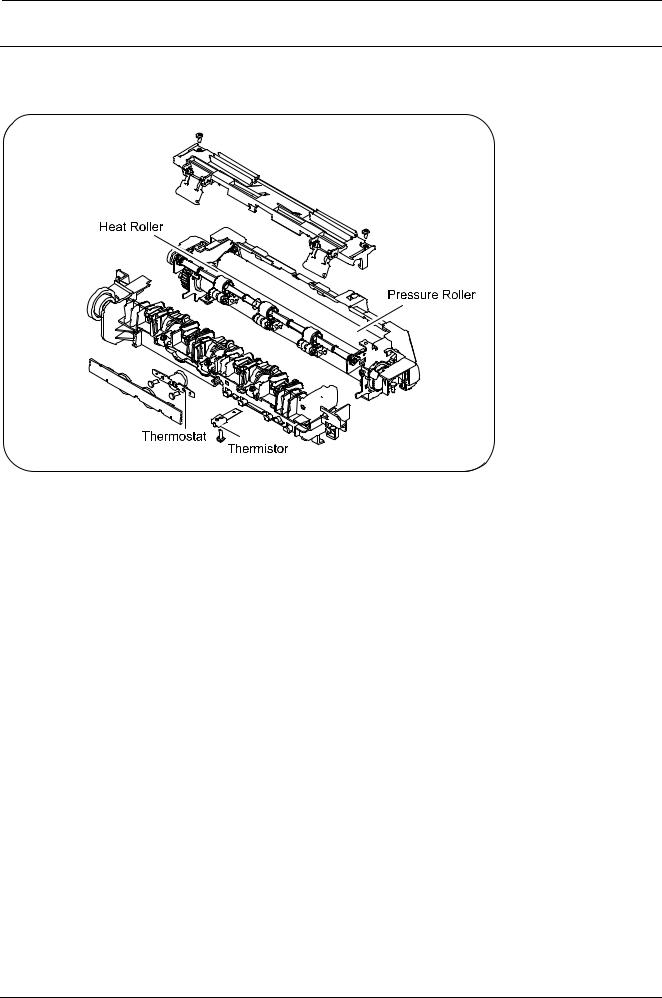
2. Product specification and description
2.2.4.4. Fuser Unit
This unit consists of Heat Roller, a Thermostat, and Thermistor, etc. It fuses the toner that was transferred by the transfer roller onto the paper, by applying heat and pressure to complete fusing process.
1)Thermostat
When a heat lamp is overheated, a Thermostat cuts off the main power to prevent overheating.
•Thermostat Type : NonContact type Thermostat
•Control Temperature : 195°C ± 5°C
2)Thermistor
It is a temperature detecting sensor.
•Temperature Resistance : 7 kΩ(180°C)
3)Heat roller
The heat roller transfers the heat from the lamp to apply a heat on the paper.
The surface of a heat roller is coated with Teflon, so toner does not stick to the surface.
4)Pressure roller
A pressure roller mounted under a heat roller is made of a silicon resin, and the surface also is coated with Teflon. When a paper passes between a heat roller and a pressure roller, toner adheres to the surface of a paper and is permanently fused.
5)Halogen Lamp
•Voltage : 110 V (115 ± 10%) / 220 V : 230 ± 10%
•Capacity : 750 Watt ± 5%
Copyright© 1995-2012 SAMSUNG. All rights reserved. |
2-18 |

2. Product specification and description
2.2.4.5. LSU (Laser Scanner Unit)
It is the core part of the LBP which switches from the video data received to the controller to the electrostatic latent image on the OPC drum by controlling laser beam, exposing OPC drum, and turning principle of polygon mirror. The OPC drum is turned with the paper feeding speed. The HSYNC signal is created when the laser beam from LSU reaches the end of the polygon mirror, and the signal is sent to the controller. The controller detects the HSYNC signal to adjust the vertical line of the image on paper. In other words, after the HSYNC signal is detected, the image data is sent to the LSU to adjust the left margin on paper. The one side of the polygon mirror is one line for scanning.
2-19 |
Copyright© 1995-2012 SAMSUNG. All rights reserved. |
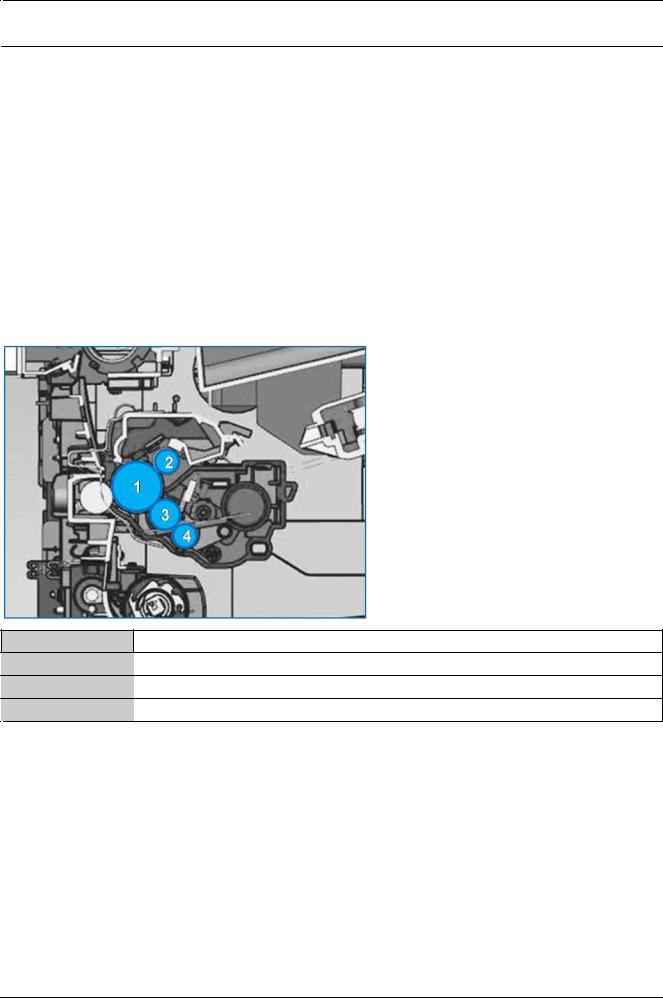
2. Product specification and description
2.2.4.6. Toner Cartridge
By using the electronic photo process, it creates a visual image. In the toner cartridge, the OPC unit and the developing unit are in a body. The OPC unit has OPC drum and charging roller, and the developing unit has toner, supply roller, developing roller, and blade.
•Developing Method : Non magnetic 1 element contacting method
•Toner : Non magnetic 1 element shatter type toner
•The life span of toner (ISO 19752 pattern / A4 standard)
-Initial toner : 1K
-Sales toner : 2.5K
•OPC Cleaning : Collect the toner by using cleaning blade
•Handling of wasted toner : Collect the wasted toner in the cleaning frame by using cleaning blade
•Classifying device for toner cartridge: ID is classified by CRUM
1OPC Drum
2Charge Roller
3Developing Roller
4Supply Roller
Copyright© 1995-2012 SAMSUNG. All rights reserved. |
2-20 |

2. Product specification and description
2.2.5. Hardware configuration
The SCX-465x_4x21 series Electrical Circuit System consists of the following:
•Main board (System board)
•OPE board
•HVPS/SMPS board
•Fax board
There are 4 types of main controller depending on model. Refer to the table below for the specification of each controller.
Design Specifications |
3–in-1 MFP |
4–in-1 MFP |
||||
SCX-4650 |
|
SCX-4650N |
SCX-4650F |
SCX-4655FN |
||
|
|
|
||||
|
|
|
|
|
|
|
ASIC |
Model |
C3N |
|
C3N |
C3N |
C3N |
|
|
|
|
|
|
|
Speed |
433MHz |
|
433MHz |
433MHz |
433MHz |
|
|
|
|||||
|
|
|
|
|
|
|
PCB |
|
|
|
4L, 140*83.25mm |
|
|
ROM |
Program |
4MB |
|
8MB |
8MB |
8MB |
|
|
|
|
|
|
|
FAX Backup |
n/a |
|
n/a |
8MB |
8MB |
|
|
|
|||||
|
|
|
|
|
|
|
RAM |
DDR2 |
64MByte |
|
64MByte |
64MByte |
128MByte |
EEPROM |
|
8KB |
|
32KB |
64KB |
64KB |
|
Engine |
A4984 |
|
A4984 |
A4984 |
A4984 |
Motor Driver IC |
Platen |
A4984 |
|
A4984 |
A4984 |
A4984 |
|
ADF |
n/a |
|
A4984 |
A4984 |
A4984 |
AFE IC |
|
LAFE1001 |
|
LAFE1001 |
LAFE1001 |
LAFE1001 |
DC/DC |
24V-5V |
G5753 |
|
G5753 |
G5753 |
G5753 |
Converter |
5V-3.3V |
SN1001043 |
|
SN1001043 |
SN1001043 |
SN1001043 |
FAX |
|
n/a |
|
n/a |
Connexant |
Connexant |
Handset |
|
n/a |
|
n/a |
China Only |
China Only |
RTC backup |
|
n/a |
|
n/a |
Yes |
Yes |
Head to China |
|
Yes |
|
Yes |
Yes |
Yes |
Wired I/F IC |
|
n/a |
|
RTL8201F |
n/a |
RTL8201F |
|
|
(10/100) |
(10/100) |
|||
|
|
|
|
|
||
USB I/F |
|
Hi-speed USB 2.0 |
|
Hi-speed USB 2.0 |
Hi-speed USB 2.0 |
Hi-speed USB 2.0 |
UI |
Panel |
2Line LCD w/o backlight |
|
|
||
|
|
|
|
|
|
|
Micom |
STM8SP103 (UART) |
|
|
|
||
|
|
|
|
|||
|
|
|
|
|
|
|
2-21 |
Copyright© 1995-2012 SAMSUNG. All rights reserved. |
